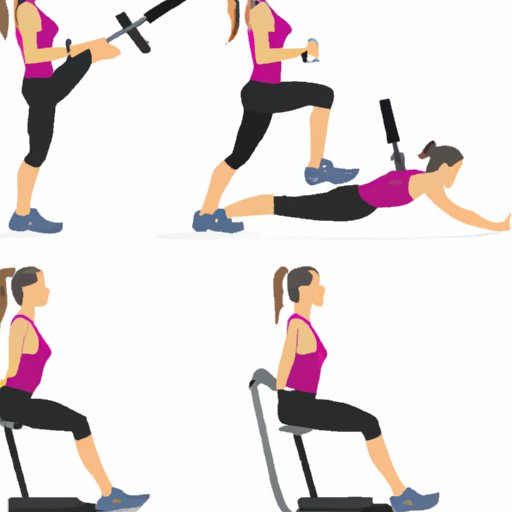Introduction
If you’ve ever taken a pilates class or tried out a home workout video, you may have wondered: is pilates an aerobic exercise? While some people consider it to be a form of cardio, others aren’t so sure. In this article, we’ll break down the aerobic benefits of pilates and provide clarity on how it can contribute to your overall fitness.
Breaking Down the Aerobic Benefits of Pilates
Before we dive into the specifics of pilates and its aerobic benefits, it’s important to understand what we mean by aerobic exercise. Put simply, aerobic exercise is any form of activity that gets your heart rate up and increases your oxygen consumption. This type of exercise has a wide range of health benefits, from boosting your cardiovascular fitness to improving your mood.
So, how does pilates fit into this definition? While it might not immediately come to mind as an aerobic workout, pilates can actually be a great way to improve your overall fitness. The slow and controlled movements of pilates require a lot of stability and core strength, which can lead to an increased heart rate and heavier breathing.
Additionally, some research studies have shown that pilates can help participants improve their aerobic fitness. One small study published in the Journal of Fitness Research found that regular pilates sessions led to significant improvements in aerobic endurance. Another study in the Journal of Bodywork and Movement Therapies found that participants who took a 12-week pilates class saw significant increases in their VO2 max, a measure of aerobic fitness.
Can Pilates Get Your Heart Pumping? Examining Its Aerobic Potential
To get a better sense of the aerobic potential of pilates, it’s helpful to look at the physiological effects it can have on your body. While it might not be as intense as running or cycling, pilates can still increase your heart rate and oxygen consumption.
One study in the Journal of Physical Therapy Science measured the effects of pilates on heart rate, blood pressure, and oxygen consumption in healthy women. They found that a 30-minute pilates session led to significant increases in heart rate and oxygen consumption, indicating that it can contribute to aerobic fitness.
Of course, compared to high-intensity exercises like running, pilates might not be as effective at increasing your heart rate and helping you reach your target heart rate zone. However, that doesn’t mean it can’t be a valuable part of your aerobic workout routine.
Cardio or Not? The Truth About Pilates and Aerobic Exercise
There’s some debate in the fitness community about whether pilates can truly be considered a cardio workout. On one hand, pilates can increase your heart rate and oxygen consumption, two key indicators of a successful cardiovascular workout. On the other hand, some argue that it’s not intense enough to really qualify as cardio.
In reality, the answer is somewhere in between. While pilates might not be the most intense aerobic exercise out there, it can still offer valuable benefits for your heart and lungs. Plus, it’s a low-impact workout that’s great for people who might not be able to handle high-impact activities like running or jumping.
Why Pilates Should Be Part of Your Aerobic Workout Routine
So, why should you consider adding pilates to your aerobic workout routine? For starters, it offers some unique benefits that other forms of cardio might not provide. For example, pilates can be a great way to improve your balance, posture, and flexibility, all of which can help prevent injuries and improve your overall quality of life.
Additionally, pilates is a low-impact workout, which means that it’s less stressful on your joints than high-impact exercises like running or jumping. This makes it a great option for people who are recovering from injuries or have joint pain.
The Surprising Aerobic Benefits of Pilates – Is it Worth the Hype?
While pilates might not be as well-known for its aerobic benefits as other types of exercise, there are some surprising advantages to incorporating it into your workout routine. For example, pilates can help improve your posture, which can lead to better breathing and more efficient oxygen consumption. It can also improve your balance and stability, which can make other forms of cardio easier and safer to do.
Real-world examples of people who have achieved aerobic fitness through pilates abound as well. Many athletes, dancers, and fitness enthusiasts incorporate pilates into their routine to help improve their overall fitness and performance.
How to Amp Up the Cardio Factor in Your Pilates Practice
If you’re looking to increase the aerobic benefits of your pilates practice, there are a few things you can do. First, try to focus on flowing movements that involve a lot of muscles. This can help increase your heart rate and oxygen consumption. You can also try adding in some more high-intensity movements like jumping jacks or squat jumps to get your heart pumping.
Finally, consider combining pilates with other forms of cardio like running or cycling. This can help you achieve the best of both worlds, getting the unique benefits of pilates while also getting a good cardiovascular workout.
Conclusion
So, is pilates an aerobic exercise? The answer is yes – and no. While it might not be the most intense cardiovascular workout out there, pilates can still increase your heart rate and oxygen consumption, making it a valuable part of any fitness routine. Whether you’re looking to improve your posture, flexibility, or overall aerobic fitness, pilates can be a great way to achieve your goals. With a little creativity and some high-intensity movements thrown in, you can get the most out of your pilates practice and take your cardiovascular fitness to the next level.
(Note: Is this article not meeting your expectations? Do you have knowledge or insights to share? Unlock new opportunities and expand your reach by joining our authors team. Click Registration to join us and share your expertise with our readers.)
